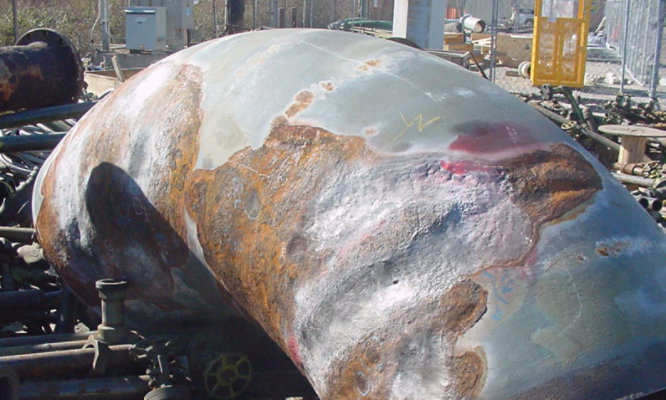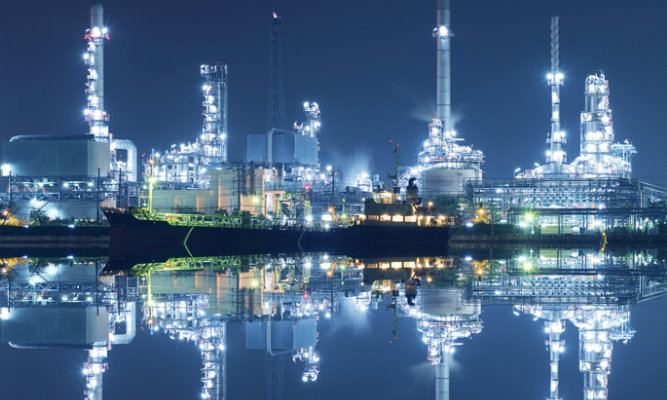Separating Flake-Reinforced Linings from the Competition
Side-by-Side Process Vessel Lining Comparison Prompts Specification Change
By John Hilton, Energy Business Development Manager, Sherwin-Williams Protective & Marine

The steel pressure vessels were brand new, freshly painted at the fabricator and put into service in the Permian Basin in Texas by one of the country’s largest crude oil producers. Yet the vessels quickly showed signs of premature deterioration after processing crude at an onshore well site. The linings inside were cracking, peeling and blistering.
For the oil company, it was hard to digest. The coating was a polycyclamine-cured lining system featuring epoxy technology that the company had used on vessels for a number of years. Mystified, the company turned to Sherwin-Williams Protective & Marine, which suggested replacing the coating, made by another manufacturer, with its own Nova-Plate® 360, a resin-based and flake-reinforced novolac launched onto the market in 2019.
The oil producer agreed to test Nova-Plate 360 alongside the product it had been using in a rare side-by-side field trial. Nova-Plate 360 performed without any signs of failures and today the company applies the product to most of its pressure vessels and heater treaters. Sherwin-Williams also advised the oil producer on how to extend the lives of the linings to help reduce the lifetime operating costs of the vessels.
Simple Solutions
The oil company had been lining the interiors of its separators, which use heat and pressure to remove water from crude oil, exclusively with the polycyclamine-cured lining. The type of coating selected as a lining is important because it must withstand temperatures and pressures ranging from 180-200°C (356-392°F) and 100-700 psi. In addition, the coating must protect against a substantial amount of hydrogen sulfide (H2S) and fracking chemicals, which are detrimental to steel, routinely entering the vessels. If the coating is damaged and starts to peel, the corrosive vessel contents will deteriorate the steel substrate, potentially causing the vessel to rust through in fewer than six months and necessitating a well shutdown that would cost production time and money. In addition, the site may become contaminated, requiring an environmental cleanup. The company would also need to purchase a new vessel.
However, problems with vessels and their lining systems are usually detected before anything drastic occurs, and that’s what happened in this case. The oil company noticed cracking, peeling and blistering in the coating, especially on the manways and hatch covers, which are subject to more operational wear and tear. Degradation on the manways and hatch covers are early signs of total system failure throughout the vessel.
The company considered various theories on why the coating was failing, but Sherwin-Williams Protective & Marine was convinced the problem came down to three simple causes:
- The vessels were operating outside their normal temperature parameters, exceeding the limits of the polycyclamine-cured lining.
- The separation process involved the injection of additives containing methanol, but the polycyclamine-cured lining was not methanol resistant.
- Improper depressurization of the vessels was damaging the coating.
The Field Test
The field test started in January 2019 at two well sites, both with two separators. One vessel at each site was coated with the polycyclamine-cured lining that had been failing, and the other two were coated with Nova-Plate 360 for direct side-by-side comparisons in both locations. The original plan was to check the coatings after three, six and 12 months, but the COVID-19 pandemic postponed those inspections due to the logistical challenges associated with third-parties visiting well sites. Therefore, the coatings weren’t examined until 16 months following application, with that lengthened timeframe ultimately providing a better real-world test. Just like in the vessels that originally experienced lining failures, the polycyclamine-cured linings in this test showed blistering and delamination on both vessels, especially on the manways and hatch covers (Figure 1). Signs indicated that the coating on the weld seams would fail next, and that could endanger the entire vessel (Figure 2). In contrast, the vessels coated with Nova-Plate 360 showed no evidence of failure (Figure 3), including on the manways (Figure 3). (Continued below figures.)
Figure 3. Compared to the peeling paint and evidence of steel corrosion in the polycyclamine-cured vessels (right), the Nova-Plate 360-lined vessels (left) remained perfectly intact, providing longer-term corrosion protection.
Figure 2. Inspection of the linings in the polycyclamine-cured vessels (right) showed signs that the coating on the weld seams would fail next, unlike in the Nova-Plate 360-lined vessels (left).
Figure 4. The Nova-Plate 360 lining showed no evidence of failure, including on the vessel manways, which are subject to heavier operational wear and tear than other areas.
Real-Life Proof
No lab test beats a field test of vessels actively in service, and this side-by-side test was especially helpful to compare the performance of the two lining systems in the harsh service environment of the Texas Permian Basin. Since the 2019/2020 trial, the oil company has switched from its former lining material of choice to Nova-Plate 360 and has applied it on additional vessels. In each case, the results have been the same – the coatings and the vessels remain pristine. Separators take a lot of punishment but are designed to last. The company’s former coating product would have failed in fewer than two years. Thanks to Nova-Plate 360, those same vessels are expected to last up to 10 years before their linings require attention.
ABOUT THE AUTHOR
John Hilton is an Energy Business Development Manager for Sherwin-Williams Protective & Marine. He has been with The Sherwin-Williams company for 34 years. He is a NACE-Certified Coating Inspector and a member of the Association for Materials Protection and Performance (AMPP). Contact: John.M.Hilton@sherwin.com
Discover More
Industry Expertise and Innovation
See how we help customers find customized solutions for their project and application challenges.
Our Oil & Gas Expertise
Explore our industry solutions and technology to help protect your assets.
LEARN MOREProduct Lookup
Find out more about our innovative coatings for a variety of industries.
FIND A PRODUCT

